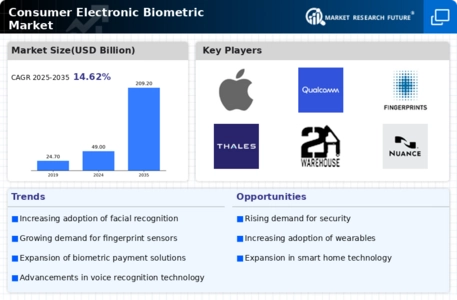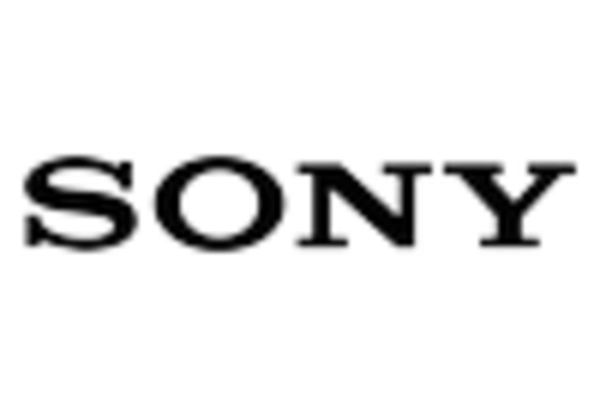Rising Adoption of Smart Devices
The proliferation of smart devices is a key driver of the Consumer Electronic Biometric Market. With the increasing integration of biometric authentication in smartphones, tablets, and smart home devices, consumers are becoming more accustomed to using biometric features for security and convenience. According to recent data, approximately 80% of smartphones now include biometric capabilities, such as fingerprint scanners or facial recognition. This widespread adoption is fostering a culture of biometric usage, leading to greater acceptance among consumers. As manufacturers continue to innovate and enhance the functionality of smart devices, the demand for biometric solutions is expected to rise, further propelling the growth of the Consumer Electronic Biometric Market.
Increasing Demand for Enhanced Security
The Consumer Electronic Biometric Market is experiencing a notable surge in demand for enhanced security solutions. As cyber threats and identity theft incidents escalate, consumers are increasingly seeking biometric systems that offer superior protection. This trend is reflected in the projected growth of the biometric market, which is expected to reach USD 50 billion by 2026. The integration of biometric authentication methods, such as fingerprint and facial recognition, into consumer electronics is becoming commonplace. This shift not only enhances security but also improves user convenience, as biometric systems eliminate the need for passwords. Consequently, manufacturers are investing heavily in developing advanced biometric technologies to meet consumer expectations, thereby driving the growth of the Consumer Electronic Biometric Market.
Expansion of E-commerce and Digital Transactions
The expansion of e-commerce and digital transactions is significantly influencing the Consumer Electronic Biometric Market. As online shopping becomes increasingly prevalent, the need for secure payment methods is paramount. Biometric authentication offers a seamless and secure way to verify identities during online transactions, thereby enhancing consumer confidence. Recent statistics indicate that e-commerce sales are projected to surpass USD 6 trillion by 2024, underscoring the necessity for robust security measures. In response, many e-commerce platforms are integrating biometric solutions, such as fingerprint and facial recognition, to streamline the checkout process while ensuring security. This trend is likely to continue, further driving the adoption of biometric technologies within the Consumer Electronic Biometric Market.
Growing Awareness of Privacy and Data Protection
As concerns regarding privacy and data protection intensify, the Consumer Electronic Biometric Market is witnessing a shift in consumer preferences. Individuals are becoming increasingly aware of the importance of safeguarding their personal information, prompting a demand for biometric solutions that prioritize data security. Biometric systems, which rely on unique physiological traits, are perceived as more secure than traditional password-based systems. This perception is driving consumers to favor products that incorporate biometric authentication. Additionally, regulatory frameworks aimed at enhancing data protection are encouraging manufacturers to adopt biometric technologies that comply with stringent privacy standards. Consequently, this growing awareness is likely to stimulate further growth in the Consumer Electronic Biometric Market.
Technological Advancements in Biometric Solutions
Technological advancements play a pivotal role in shaping the Consumer Electronic Biometric Market. Innovations in sensor technology, machine learning, and artificial intelligence are enhancing the accuracy and efficiency of biometric systems. For instance, the introduction of 3D facial recognition technology has significantly improved the reliability of identity verification processes. Furthermore, the market is witnessing the emergence of wearable biometric devices, which are gaining traction among health-conscious consumers. These devices not only monitor health metrics but also incorporate biometric authentication features, thereby expanding their utility. As technology continues to evolve, it is likely that the Consumer Electronic Biometric Market will see an influx of new products that leverage these advancements, catering to a diverse range of consumer needs.

















Leave a Comment